In this project, we are going to set up an ownCloud server on the Raspberry Pi. This server can act as your very own personal cloud storage.
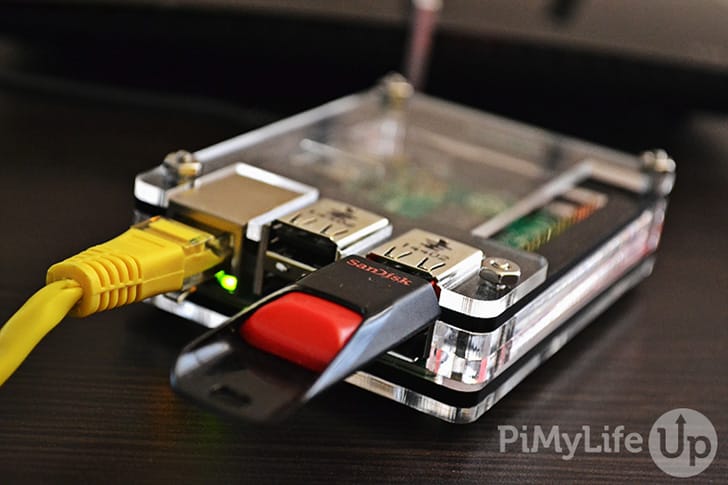
As protecting your privacy becomes harder and harder, you may be considering moving your files to a private self-hosted cloud storage. If this is the case, then this tutorial is perfect for you.
The ownCloud web interface is very similar to the many cloud storage providers that are available, such as Dropbox, Google Drive, and more. This similarity will make changing over to the self-hosted software much easier.
It is important to remember that since your data will be stored on your home network, you will end up with using more bandwidth if you upload and download files from outside your network.
This tutorial will take you through everything you need to know to get ownCloud setup and accessible.
If you are curious and want to learn more about the ownCloud software, be sure to check out the ownCloud website.
Equipment
I made use of the following equipment for this personal cloud storage setup.
Recommended
- Raspberry Pi Amazon
- Micro SD Card Amazon
- Ethernet Cable Amazon or Wi-Fi Amazon
- External Hard Drive Amazon or USB Drive Amazon
Optional
Note: It is highly likely that the USB ports on the Raspberry Pi will be unable to power an external hard drive so you may need to invest in a powered USB hub.
We last tested this tutorial on the Raspberry Pi 5 running Raspberry Pi OS Bookworm. We highly recommend that you update the to the latest operating system for the best experience.
Video
If you are a visual person and would like to see our video on how to put this tutorial together, check out the video below.
It will take you through everything you need to know get your Raspberry Pi ownCloud server up and running.
Setting up The Raspberry Pi ownCloud Server
Firstly, you will need to have a Raspberry Pi with an OS installed. If you haven’t installed Raspberry Pi OS, then check out our guide on installing Raspberry Pi OS. We recommend using the latest version for the best performance and reliability.
There are quite a few ways you can install ownCloud onto your Raspberry Pi. In this tutorial, we will be using Docker to set up ownCloud.
In our previous version of this tutorial, we used Nginx, but this method is deprecated, and we now recommend using Docker, especially since ownCloud still relies on PHP7.4.
Installing Docker
The first thing we need to do is install Docker on our Raspberry Pi. We will need this software to run the ownCloud software.
1. Firstly, in the terminal or via SSH, we will need to update the Raspberry Pi and its packages. Do this by entering the following two commands.
sudo apt update
sudo apt upgrade -yCopy2. You will need to ensure that you have Docker on your Raspberry Pi before proceeding to the next few steps. If you already have it installed, go to step 3.
If you need to install Docker, run through our tutorial on setting up Docker on the Raspberry Pi. It will take you through all the steps to set up the software correctly.
https://pimylifeup.com/raspberry-pi-docker/Creating the Required Directories
3. We now need to create the directories for where we will store the compose file and environment variables.
You can do this by running the mkdir command. The “-p” option will create any missing directories.
sudo mkdir -p /opt/stacks/owncloudCopy4. Now change into the newly created directory by using the cd command.
cd /opt/stacks/owncloudCopySetting up the Docker Compose File
5. Before we proceed, we will need to get the IP address of the Raspberry Pi. You will need to use the IP address in the environment file and to access the ownCloud web interface.
I recommend that you set your Raspberry Pi IP to static to avoid it changing in the future.
To get the IP address of the Raspberry Pi, enter the hostname command with the option “-I“.
hostname -ICopy6. It is time to write a compose file for our ownCloud setup. This file is a set of instructions Docker will run through to set up all the relevant services with the specified options. Alongside ownCloud, we will be setting up a MySQL and a Redis server.
Create and edit this file by running the following command. We will be using the nano text editor.
sudo nano compose.yamlCopy7. In this file, copy and paste the following text. Thankfully, we do not need to make any changes to this file, as any extra configurations will be stored in an environment file.
services:
owncloud:
image: owncloud/server:${OWNCLOUD_VERSION}
container_name: owncloud_server
restart: always
ports:
- ${HTTP_PORT}:8080
depends_on:
- mariadb
- redis
environment:
- OWNCLOUD_DOMAIN=${OWNCLOUD_DOMAIN}
- OWNCLOUD_TRUSTED_DOMAINS=${OWNCLOUD_TRUSTED_DOMAINS}
- OWNCLOUD_DB_TYPE=mysql
- OWNCLOUD_DB_NAME=owncloud
- OWNCLOUD_DB_USERNAME=owncloud
- OWNCLOUD_DB_PASSWORD=owncloud
- OWNCLOUD_DB_HOST=mariadb
- OWNCLOUD_ADMIN_USERNAME=${ADMIN_USERNAME}
- OWNCLOUD_ADMIN_PASSWORD=${ADMIN_PASSWORD}
- OWNCLOUD_MYSQL_UTF8MB4=true
- OWNCLOUD_REDIS_ENABLED=true
- OWNCLOUD_REDIS_HOST=redis
healthcheck:
test: ["CMD", "/usr/bin/healthcheck"]
interval: 30s
timeout: 10s
retries: 5
volumes:
- ${OWNCLOUD_FILES_LOCATION}:/mnt/data
mariadb:
image: mariadb:10.11 # minimum required ownCloud version is 10.9
container_name: owncloud_mariadb
restart: always
environment:
- MYSQL_ROOT_PASSWORD=owncloud
- MYSQL_USER=owncloud
- MYSQL_PASSWORD=owncloud
- MYSQL_DATABASE=owncloud
- MARIADB_AUTO_UPGRADE=1
command: ["--max-allowed-packet=128M", "--innodb-log-file-size=64M"]
healthcheck:
test: ["CMD", "mysqladmin", "ping", "-u", "root", "--password=owncloud"]
interval: 10s
timeout: 5s
retries: 5
volumes:
- ./mysql:/var/lib/mysql
redis:
image: redis:6
container_name: owncloud_redis
restart: always
command: ["--databases", "1"]
healthcheck:
test: ["CMD", "redis-cli", "ping"]
interval: 10s
timeout: 5s
retries: 5
volumes:
- ./redis:/dataCopyOnce you are done, save and exit by pressing CTRL + X, Y, and then ENTER.
8. It is time to write the environment file. This file will contain all the configurations we wish to set for the ownCloud software. For example, usernames, passwords, ports, and more. Docker automatically reads it and will match and replace the placeholders in the compose file with the relevant data from the environment file.
To create the environment file, enter the following command.
sudo nano .envCopy9. In this file, you will need to enter the following lines and replace each placeholder with the value you wish to use. We will explain each of these options below.
OWNCLOUD_VERSION=<VERSION>
OWNCLOUD_DOMAIN=<DOMAINORIP>:<HTTPPORT>
OWNCLOUD_TRUSTED_DOMAINS=<DOMAINORIP>
ADMIN_USERNAME=<ADMINUSERNAME>
ADMIN_PASSWORD=<ADMINPASSWORD>
HTTP_PORT=<HTTPPORT>
OWNCLOUD_FILES_LOCATION=<MOUNTPATH>Copy<VERSION>This placeholder represents the version of ownCloud you want to run on your Raspberry Pi. I recommend using thelatest, but you can always specify an older version such as10.<DOMAINORIP>Use this option to specify the allowed address for accessing the ownCloud instance. For example, if I want to use it locally, I will use the local IP, such as192.168.0.15.
If I want to access the software remotely, I can use an external IP address or domain name. You can add multiple domains and IPs by separating each of them with a comma. For example,192.168.0.15,test.pimylifeup.com. Please note, that multiple IPs and domains only applies to theOWNCLOUD_TRUSTED_DOMAINSvariable.<HTTPPORT>This is the default port that ownCloud will listen on. I recommend using a port such as8080or similar to avoid conflicts with other software.<ADMINUSERNAME>Replace this placeholder with the username you wish to use for your admin account. You will not be able to change this after the first setup.<ADMINPASSWORD>Like the username, the admin password is only used for the first setup. Afterward, you will need to change the password in the web interface.<MOUNTPATH>This is the path for storing the data of ownCloud. Using.datawill store it within/opt/stacks/ownclouddirectory. You can change this directory to wherever suits you the best.
You could set it to a mounted drive by using something like/mnt/usb1/owncloud. A mounted drive is a good option as it allows you to gain access to a lot of storage space.
OWNCLOUD_VERSION=latest
OWNCLOUD_DOMAIN=192.168.0.15:8080
OWNCLOUD_TRUSTED_DOMAINS=192.168.0.15
ADMIN_USERNAME=pimylifeup
ADMIN_PASSWORD=pimylifeup
HTTP_PORT=8080
OWNCLOUD_FILES_LOCATION=./dataCopyOnce you are done, save and exit the file by pressing CTRL + X, Y, and then ENTER.
Starting the ownCloud Server with Docker
10. To start your ownCloud server, all you need to do is run the following command.
Once initiated, Docker will download all the required software and start up each of the service with the specified options. Using the -d option will run Docker in the background.
docker compose up -dCopyFirst Start of ownCloud on the Raspberry Pi
I will briefly go through the basics of ownCloud running on the Raspberry Pi. If you want more information, I highly recommend checkout out the manuals on their website. You can find them at the ownCloud manual site here.
11. In your favorite web browser, you need to go to your Raspberry Pi’s IP address.
If you don’t know your IP address, you can run the hostname command on the Raspberry Pi.
hostname -ICopyBelow is an example of the address you will need to enter into the browser. Remember to update the IP address with the one you get from using the command above.
http://192.168.0.15:808012. You should now be greeted with a login page similar to the one below. Simply enter the username and password that we set in the environment file.

13. You will now see a page with a pop-up on how you can install the apps for desktop, Android, and iOS.
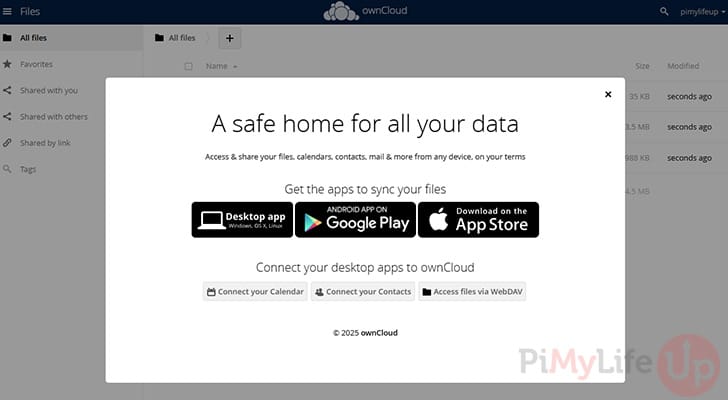
14. Lastly, test that you can upload files to your ownCloud installation by simply dragging and dropping a file into the web interface. It should upload without any issues.
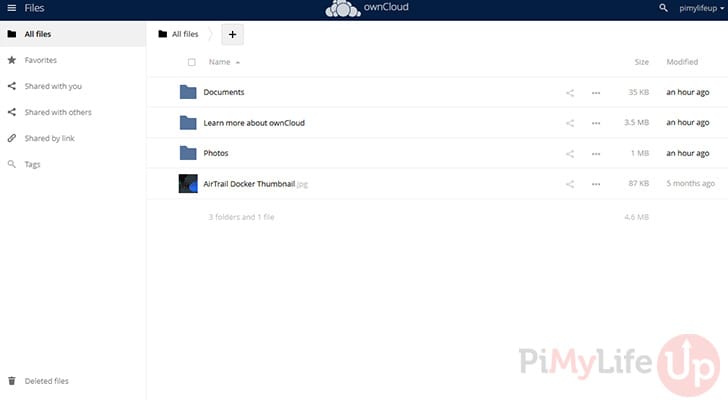
15. You now have ownCloud installed and running on your Raspberry Pi. The next couple of sections cover the basics for remote access, updating software, and backing it up to somewhere secure.
Setting up Remote Access
If you want to access the server remotely, I highly recommend using a service like Cloudflare Tunnels or Tailscale. These services are relatively easy for most people to understand and setup. Alternatively, setting up a reverse proxy like Traefik, or Nginx proxy manger will also work.
Once you have chosen your method of exposing ownCloud to the internet you will simply need to specify the IP address and port of the software. Most of the software above will generate certificate for your domain name.
Updating ownCloud Docker
Using Docker makes updating your ownCloud software super easy, and only involves a few simple steps.
1. Before you update, we recommend that you backup any data in case something goes wrong with the update. Follow our backup section for more information.
2. You will need to first change to the location of your ownCloud compose file. If you followed this tutorial, use the command below.
cd /opt/stacks/owncloudCopy3. You can simply tell Docker to pull the latest versions of the software specified in the compose file.
docker compose pullCopy4. Once the latest software has been downloaded, you must issue the compose up command. This command ensures that the software running in docker is updated to the latest versions we downloaded earlier.
docker compose up -dCopyBacking up ownCloud Docker
Backing up your data is highly important as data drive failure, natural disasters, corruption, or accidental deletion can happen at any time and when you least expect it. Luckily, backing up data is relatively straightforward.
I recommend you can use rclone on the Raspberry Pi or something similar to copy and store the data in another location. You can also automate the following steps using a bash script and setting up cron.
1. You will need to first change into the location of the compose file.
cd /opt/stacks/owncloudCopy2. First, stop the docker container by running the following command
docker compose stopCopy3. The next couple of lines require you to have rclone installed, but they will simply sync the contents from the source location to the destination. For example, /opt/stacks/owncloud/data will sync to /backups/owncloud/data.
You can also setup rclone to sync to a remote location rather than local. This method is highly recommended for backing up important data.
sudo rclone sync /opt/stacks/owncloud/data /backups/owncloud/data --progress
sudo rclone sync /opt/stacks/owncloud/mysql /backups/owncloud/mysql --progressCopy4. Once the above two commands are finished, start the docker container by running the following command.
docker compose up -dCopyAs I mentioned earlier, you can add the above commands into a bash script that you can then automate the backup sequence. I highly recommend that you schedule the backup to occur when the server is least likely to be in use.
Conclusion
I hope this tutorial has helped you set up your very own Raspberry Pi ownCloud. You should now be able to upload and store files within your own personal cloud.
If you are interested in other self-hosted projects, I also recommend taking a look at Immich on the Raspberry Pi. It is a great software for storing and viewing photos.
If you have any troubles, want to leave feedback or if I have missed anything feel free to drop us a comment below.
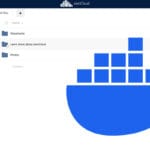

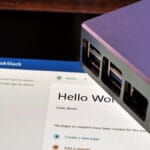
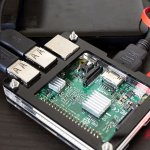



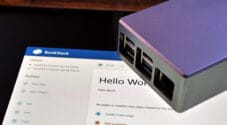
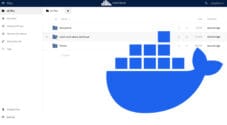
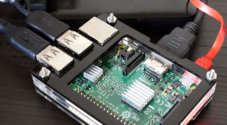
Great tutorial.
All works – but i have a question.
How can I change the directory of the data? Whenver I am changing it to my nfs – I am getting error and the web page is saying to contact the administrator.
so it works with ‘datadirectory’ => ‘/var/www/owncloud/data’
but not with /mount/nfs
Any idea how can we do it
Getting Forbidden Error on Step 5. any one know why this is?
Hi Gus
Any ideas on Forbidden messages when doing step 5?
Hi seb,
Is it step 5 under the header “Setting up The Raspberry Pi Owncloud Server” or under a different header? Just want to make sure i am looking at the right step.
Hi Gus
yes this under that section.
I’ve got a local NAS device which presents via CIFS/SMB2 or NFS.. could I adapt this to present a CIFS share or NFS mount to the Pi Owncloud server ?
All we need now is a NextCloud tutorial – the OwnCloud ‘replacement’
I’ll take a look into it!
hi i tried using my pi’s ip address but the browser showed this error
ERR_CONNECTION_TIMED_OUT
192.168.1.116 took too long to respond.
PLEASE HELP!!!!!
I follow everything maybe . but when i access its ip number the reply is bad gateway . Where to check ?
Hey mates, trying to get this working, and everything boots up correctly, no failed start ups, but when I try accessing it through the browser, all I get is
The 192.168.1.114 page isn’t working
192.168.1.114 redirected you too many times.
Try:
Reloading the page
Clearing your cookies
ERR_TOO_MANY_REDIRECTS
Any idea what could cause this?
You added:
upload_max_filesize=2000Mpost_max_size=2000M
memory_limit=2000M
You mean with upload max file size the max size a file can be on your cloud which you put 2000mb which is approximately 2gb?
If yes can i add more like:
upload_max_filesize=10000Mpost_max_size=10000M
memory_limit=10000M
guys, open port 80 and 443 on your router and you will have access from outside! I was looking for this solution for a long time…
Hi, i did my server according to your instructions here. Everything works fine, but i have problem with PORT forwarding (NAT).
I added pi IP and port 80 to list, but still i cannot connect to my server from outside. In router i have few fields to choose from: FTP, SFTP WEB… What kind of server is this? SFTP?
Cheers
Hey Gus!
Awesome tutorial!
For some reason (I’m wondering if this is outdated) I can’t seem to auto-mount my drive. Mounting works just fine and I can access accordingly, but it won’t automount. I tried adding an additional line of code in my fstab file. No luck.
Is this as up-to-date as could be? And any particular ressource I could use to double check the automounting?
I am on step 19 and entering first:
sudo mkdir -p /var/www/owncloudThen on the second line I am entering:
sudo wget https://download.owncloud.org/community/owncloud-8.1.1.tar.bz2The challenge is that I am getting an error that says:
"Cannot write to 'owncloud-8.1.1.tar.bz2.5' (no space left on device).Did I do something wrong? Do I need more memory?
Hi JP,
Sounds like Raspbian isn’t taking up the entire SD card thus out of room. To make sure it is please do the following.
In the terminal enter:
sudo raspi-configIn here select “expand filesystem” then exit & reboot the Pi.
Hi Gus,
I have everything working! Great Tutorial.
But I want my motion webcam raspberry pi to write directly the /media/ownclouddrive that I shared over samba in the owncloud raspberry pi… but I get “no permitions” error… I can’t write to the directory, even as “pi“ user on the owncloud raspberry pi… can this be done?
I afraid I’m not at ease with linux to make this on my own…
Can someone help me?
Thanks!
Antonio
Every time now that I get done mounting an external drive, my Pi won’t start and enters emergency mode. It is an external hard drive attached through a powered usb hub.
hi, I have a problem at
sudo wget https://download.owncloud.org/community/owncloud-8.1.1.tar.bz2(Cannot write to ‘owncloud-9.0.1.tar.bz2’ (No space left on device).
I’m using raspberry pi 2 model B and sd card 8 gb, I need a solution?
Hi Indra,
You will need to expand Raspbian to take up your entire SD Card.
In the terminal enter:
sudo raspi-configIn here select “expand filesystem” then exit & reboot the Pi.
Thanks for you respond Gus, i will to try 😀
Hi,
Thanks for the tutorial. After step #18, I can’t login to the GUI desktop of my Pi. It asks me for a username/password and I can’t log in using the default ones. Do you have any fix for this?
I look forward to hearing from you.
Jamal
Hi.
Some times will my pi not boot, it freezes at the line:
[OK] found device /dev/ttyacm0
And everytime i takke something out or plug something into the usb ports my pi reboots.
Is there a known fix for this?
Thnak you in advance.
Hi Gus,
Awesome tutorial, though I have made a mistake. I did not click on storage and database when setting up my owncloud account, so I don’t think my external drive is being used. Is there any way to fix this?
Hi Nathaniel! I did the same, and although I haven’t tried this solution already (I’m yet to buy a powered hub for my drives), I figured this could be a solution: as discussed in the port forwarding section of this guide, you should do this:
sudo nano /var/www/owncloud/config/config.php
then there you can edit the path where data is stored. And probably you should write the path to the folder which you mounted the drive to, not the drive itself (or you can try both).
Tell us if you succeed.
Hi I have a question. I’m a complete newb when it comes to this stuff and I have a basic knowledge of using ubuntu. I know that raspberry pi uses linux but I will be accessing “my cloud” primarily from windows and apple devices, will this cause an issue with syncing and accessing my files? Thanks.
Cannot write to ‘owncloud-8.1.1.tar.bz2.1’ (No space left on device).